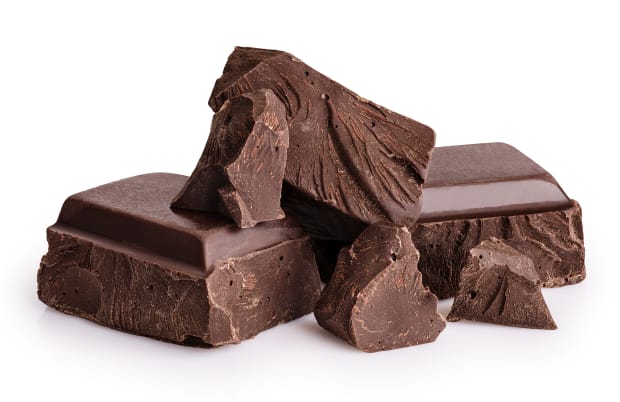- Like
- SHARE
- Digg
- Del
- Tumblr
- VKontakte
- Flattr
- Buffer
- Love This
- Save
- Odnoklassniki
- Meneame
- Blogger
- Amazon
- Yahoo Mail
- Gmail
- AOL
- Newsvine
- HackerNews
- Evernote
- MySpace
- Mail.ru
- Viadeo
- Line
- Comments
- Yummly
- SMS
- Viber
- Telegram
- JOIN
- Skype
- Facebook Messenger
- Kakao
- LiveJournal
- Yammer
- Edgar
- Fintel
- Mix
- Instapaper
- Copy Link
A 3-ounce serving (45–60 percent cacao) of dark chocolate has 7 mg, or about 39% of the daily value
Adobe Stock
You know iron is critical for building red blood cells and many other physiological functions. Here’s the good news: you don’t have to eat liver (or even red meat) to get this important mineral. But if you follow a meat-free diet, there are a few things you should know. First, iron comes in two forms: heme iron, found in meat, is the most readily available to the body. The form found in plants, called non-heme iron, is less efficiently absorbed. To further complicate matters, phytic acid, a compound found in legumes, nuts, and grains—abundant in plant-based diets—inhibits the availability of iron and other minerals.
That doesn’t mean you can’t get enough iron without eating meat. To enhance your absorption of this important mineral, soak beans, grains and legumes before cooking to reduce their phytic acid content (sprouting has a similar effect). And include more foods rich in vitamin C, such as broccoli, red peppers, strawberries, and kiwi fruit, in your diet. Studies show that vitamin C enhances iron absorption and, in some cases, may offset the effects of phytic acid. Here are eight great iron-rich foods to try.
1. Oysters
With 8 mg of iron in a 3-ounce serving or about 44 percent of the daily value, they’re four times higher in iron than red meat, and have almost twice as much iron as liver. And oysters contain the readily available heme type of iron.
Recipe Tips: Steam oysters and serve with garlic butter; broil oysters and top with shallots and minced tarragon; simmer oysters, celery, and onions in milk or cream and top with parsley for a simple oyster soup.
2. Dark chocolate
Happily, dark chocolate is a great source of iron. A 3-ounce serving (45–60 percent cacao) has 7 mg, or about 39 percent of the daily value. Cacao nibs are similar in iron content, plus they’re sugar-free and, like dark chocolate, high in antioxidants.
Recipe Tips: Dip strawberries in melted dark chocolate for an easy, elegant dessert; purée cacao nibs, cherries, and coconut milk for an iron-rich breakfast smoothie; make a mole with unsweetened dark chocolate, tomatoes, peppers, onions, garlic, and spices.
3. Spinach
Spinach is rich in iron, with 6.5 mg (about 35 percent of the daily value) per cup. Swiss chard is another good source. One cup, cooked, has about 4 mg of iron. And both are high in vitamin C, which enhances iron absorption.
Recipe Tips: Sauté chopped spinach with red peppers and cooked black lentils; brush whole Swiss chard leaves with olive oil and grill until tender; make an iron-rich salad with shredded spinach, sliced strawberries, and toasted walnuts.
4. White Beans
White beans are one of the richest sources of plant-based iron, with 8 mg, or about 44 percent of the daily value, per cup. Black beans, kidney beans, and chickpeas are also excellent plant-based sources of iron, with 4–5 mg per cup.
Recipe Tips: Purée white beans with sautéed garlic, leeks, vegetable broth, and nutritional yeast for a creamy, iron-rich alfredo sauce; sauté chickpeas in olive oil with minced red peppers, red onions, and spinach; toss black beans with broccoli florets, cooked corn, and a cilantro-lime vinaigrette.
5. Lentils
Lentils, like white beans, are loaded with iron. One cup contains 6 mg, or about 34 percent of the daily value. Red, black, and sprouted lentils have similar amounts, and black lentils are also high in polyphenol antioxidants.
Recipe Tips: Combine lentils with cooked quinoa, red peppers, and minced shallots; toss black lentils with cubed sweet potatoes, scallions, and spinach; sauté chickpeas with shredded Swiss chard, garlic, harissa, and cumin.
6. Tempeh
A half-cup serving contains roughly 4.5 mg of iron, about 28 percent of the daily value. Tofu and edamame have similar amounts. The advantage of tempeh: the fermentation process breaks down phytic acid, improving iron absorption.
Related: Double Decker Tempeh Reuben recipe
Recipe Tips: Simmer cubed tempeh with onion and garlic in tomato sauce; toss tempeh slices with olive oil and garlic powder, grill until browned, and serve with grilled chard; make a colorful slaw with shredded red cabbage, carrots, scallions, and edamame.
7. Cooked tomatoes
Cooked tomatoes are a great source of iron, and they’re high in vitamin C. The highest: canned puréed tomatoes, with 4.5 mg per cup, or about 28 percent of the daily value. Crushed tomatoes and tomato sauce are other good iron sources.
Recipe Tips: Simmer white beans, broccoli, and leeks in tomato sauce; make vegan chili with puréed tomatoes, crumbled tempeh, kidney beans, onions, and garlic; whip up homemade salsa with canned tomatoes, minced scallions, jalapeño peppers, and cilantro.
8. Sardines
8. Sardines are higher in iron than salmon, tuna, or shrimp.A three-ounce serving has 2 mg, or about 11 percent of the daily value. And like other animal products, it contains the more readily available heme type of iron.
Recipe Tips: Mix canned sardines with mashed avocado and minced red onion for a tuna-fish alternative; serve sardines in tacos and top with salsa, slaw, and crumbled cotija cheese; make a twist on Salade Niçoise with spinach, sardines, Kalamata olives, boiled eggs, and cooked green beans.
Iron values taken from the USDA National Nutrient Database for Standard Reference.


